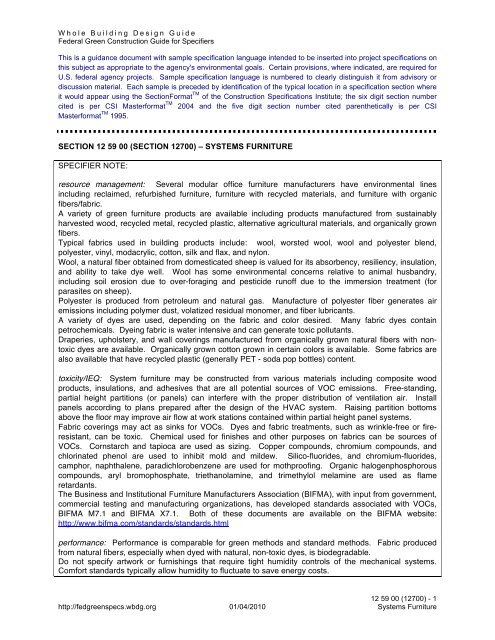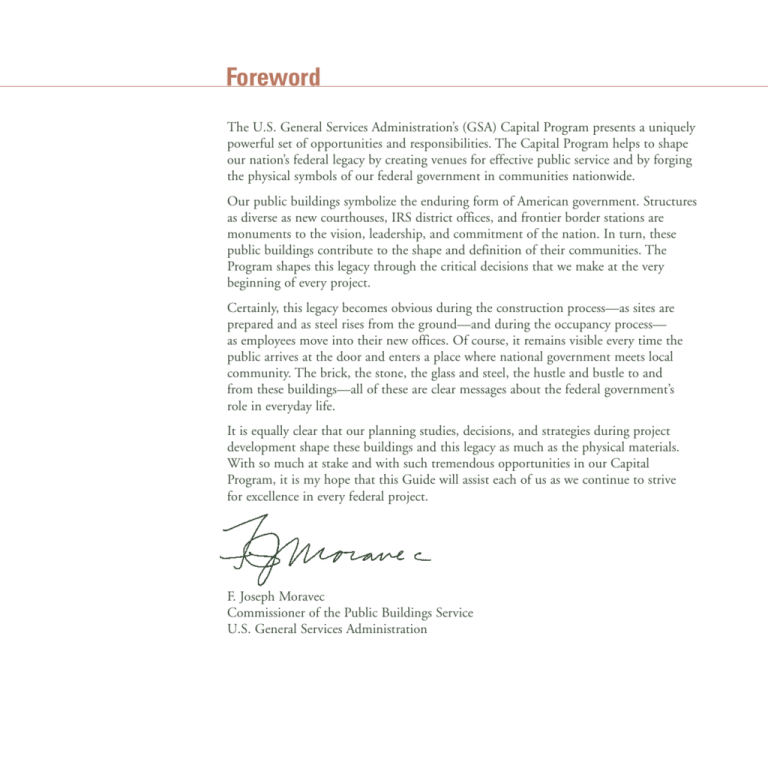Home National Institute of Building Sciences
Table Of Content

The WBDG’s Building Commissioning section presents information about current approaches and processes as well as overcoming challenges and emerging issues. It also has been expanded to address Existing Buildings and Ongoing Commissioning. The United States Army Corps of Engineers (HQUSACE), Naval Facilities Engineering Systems Command (NAVFAC), and the Air Force Civil Engineer Center (AFCEC) are responsible for administration of the UFC system. Points of contact and procedures for the development and maintenance UFC documents are prescribed in the latest edition of MIL-STD-3007. The National Institute of Building Sciences developed the WBDG-Whole Building Design Guide to foster communication and knowledge-sharing among federal, industry and academic partners to advance high-performing facilities. ESG is a growing movement that helps define and assess the impacts of businesses and companies on Environmental, Social, and Governance issues.
An Introduction To ESG: Environmental, Social, And Governance Issues
We bring together experts from throughout the building industry, design, architecture, construction, and government. In 1989, DoD adopted the Construction Criteria Base (CCB) information system as the official distribution method for facilities criteria. Over the years, the military services have been instrumental in the advancement of CCB and in 2003 adopted its evolution into the Whole Building Design Guide (WBDG). Previously, each service had its own publishing system resulting in criteria being disseminated in different formats.
Unified Facilities Guide Specifications (UFGS)
This approach is a deviation from the typical planning and design process of relying on the expertise of specialists who work in their respective specialties somewhat isolated from each other and often in a linear manner. Private sector programs, including LEED®, Green Globes, the Living Building Challenge, and many other rating systems, define standards and measures for sustainable buildings and entire neighborhoods. Also, the Building Security Council's (BSC) Building Rating System and certification for professionals was created to help measure and benchmark security in buildings. The private sector and industry also responded by creating more products and systems that have multiple benefits. The knowledge, materials, and systems exist and are readily available to make a positive impact on the environment and on the quality of life of building occupants.

INDUSTRY LEADERSHIP

They provide shelter, encourage productivity, embody our culture, and certainly play an important part in life on the planet. Buildings today are life support systems, communication and data terminals, centers of education, justice, community, and so much more. They are incredibly expensive to build and maintain and must constantly be adjusted to function effectively over their life cycle. The Installation Facilities Standards (IFS) program is part of the Air Force Corporate Facilities Standards (AFCFS) program; and assists bases in implementing and maintaining facilities standards as appropriate for efficient operations within the respective climate region. The Whole Building Design Guide - WBDG () is one of the largest web-based portals providing government and industry practitioners with one-stop access to up-to-date information on a wide range of building-related guidance, criteria and technology from a 'whole buildings' perspective. Through a systematic analysis of these interdependencies, and leveraging whole building design strategies to achieve multiple benefits and synergies, a much more efficient and cost-effective building can be produced.
LEED certification for new interiors U.S. Green Building Council - USGBC
LEED certification for new interiors U.S. Green Building Council.
Posted: Mon, 20 Jan 2020 08:32:15 GMT [source]
The 'Whole Building Design' process draws from the knowledge pool of all the stakeholders across the life cycle of the project, from defining the need for a building, through planning, design, construction, building occupancy, and operations. Guides and Specifications augment the integrated design approach outlined by the WBDG. Guides offer a deep dive into building enclosure components—as well as calculator tools that aid the design and specification of mechanical insulation. Specifications serve the agencies that create them and offer valuable design advice for specific building types in the public and private sectors.
Unified Facilities Criteria Program
The publications and resources listed in this section are produced in accordance with the NIBS mission to serve the public interest by advancing building science and technology to improve the built environment. The recommendations found in many of these documents are often arrived at through a member consensus of broad-based building interests, serving on a NIBS council. The WBDG was created and continues to evolve as the only online portal providing built environment practitioners access to relevant building-related guidance, up-to-date federal criteria, new technology information, and workforce development training from a 'whole building' perspective. General Services Administration (GSA), the Department of State Bureau of Overseas Buildings Operations (OBO), and the Department of Homeland Security.
INDUSTRYEVENTS
As the world of buildings continues to change and grow in complexity, additional programs and information will have an impact on the entire design, planning, and construction community. Among them is Building Information Modeling (BIM) software that is a continued trend in computer-aided design. BIM also aids in the process of integrating the various design teams' work, furthering encouraging and demanding an integrated team process. BIM supports continuous monitoring and management to operate and optimize a project throughout its life cycle. To create a successful high-performance building, an interactive approach to the design process is also required. It means all the stakeholders—everyone involved in the planning, design, use, construction, operation, and maintenance of the facility—must fully understand the issues and concerns of all the other parties and interact closely throughout all phases of the project.
World Energy Outlook 2023
The Energy Independence and Security Act (EISA) of 2007 further established a new and aggressive plan for achieving energy independence in our nation's building stock by the year 2030. The Act requires that federal buildings (new and renovations) achieve fossil fuel-generated energy consumption reductions on the order of 55 percent in the year 2010 to 100 percent by 2030. The Act also requires that sustainable design principles be applied to siting, design, and construction. The commissioning process is an emerging and growing industry where the entire commissioning team, including design, construction and operations, needs to communicate and understand their functions to maximize the results of the project. This understanding that commissioning is not an event but a process that extends from project start through design, construction and operation benefits all team members. The commissioning industry needs to provide information and training to enhance the process as it has done in this WBDG revision.
About the Construction Process
Zero Energy Building Project Profiles: Offices - Energy.gov
Zero Energy Building Project Profiles: Offices.
Posted: Fri, 02 Sep 2022 10:12:58 GMT [source]
WBDG is a gateway to up-to-date information on integrated 'whole building' design techniques and technologies. The goal of 'Whole Building' Design is to create a successful high-performance building by applying an integrated design and team approach to the project during the planning and programming phases. Each design objective may be significantly important or unique in any project, yet a truly successful one is where project goals are identified early on and held in proper balance during the design process.
Questions or interpretations pertaining to these documents or situations should be referred to the Contracting Officer. That task is accomplished by the WBDG Resource Pages which are written by industry experts explaining strategies, technologies, applications, standards, and emerging issues relevant to the subject along with links to related WBDG pages, external websites, publications, and points of contact. Requests to deviate from any installation facilities standards, that are Unified Facilities Criteria (UFC) requirements, will follow the process outlined in the AFCFS for UFC waivers and exemptions. Established by the United States Congress, NIBS' mission is to serve the public interest by advancing building science and technology to improve the built environment. These members contribute their knowledge and experience to the WBDG and collaborate with industry organizations and subject matter experts to better serve the building community.
These may include documents that are beyond the scope of the IFS and are programmatic, procedural or highly technical in nature. Our members' research and guidance help inform local and state governments and develop federal programs to lesson the impacts of these disasters on our communities. To foster communication and knowledge-sharing among federal, industry and academic partners by leveraging WBDG-Whole Building Design Guide services to advance high-performing facilities. Questions, comments, suggestions and recommended changes for these documents are welcome and should be submitted as a Criteria Change Request (CCR). To submit a Criteria Change Request, click on the CCR link next to the document below. CCRs are not appropriate when they pertain to a specific project solicitation, request for proposal or after a project award.
The WBDG is unique as it represents a collaborative effort among not only government agency subject matter experts but also those from private sector companies, non-profit organizations, and educational institutions all contributing their knowledge and experience to better serve the building community. Should you have any questions or comments on the WBDG, please feel free to contact our team at At their best, they connect us with the past and represent the greatest legacy for the future.
Whole Building Design encompasses all of these issues and programs and is an essential way of approaching building projects. Understanding Whole Building Design concepts will enable you to think and practice in an integrated fashion to meet the demands of today's as well as tomorrow's high-performance building projects. Energy Information Administration illustrates that buildings are responsible for 40% of greenhouse gas emissions annually. Of those total emissions, building operations are responsible for 27% annually, while building and infrastructure materials and construction (typically referred to as embodied carbon) are responsible for an additional 13% annually. A few of the many building materials are responsible for 23% of total global emissions. Seventy-six percent of all electricity generated by U.S. power plants goes to supply the building sector1 and buildings often contribute to health problems such as asthma and allergies due to poor indoor environmental quality.
Comments
Post a Comment